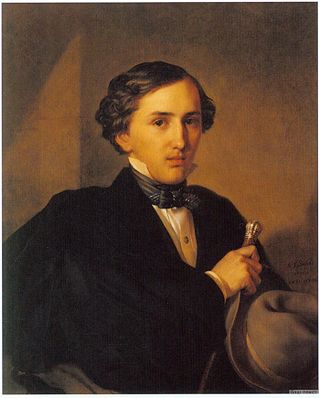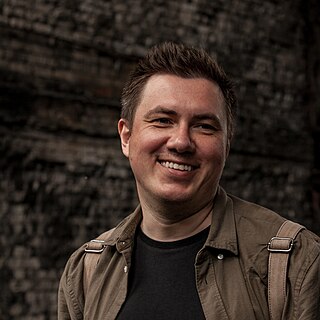
Saratov is the largest city and administrative center of Saratov Oblast, Russia, and a major port on the Volga River. As of the 2021 Census, Saratov had a population of 901,361, making it the 17th-largest city in Russia by population. Saratov is 389 kilometres (242 mi) north of Volgograd, 442 kilometres (275 mi) south of Samara, and 858 kilometres (533 mi) southeast of Moscow.

Peredvizhniki, often called The Wanderers or The Itinerants in English, were a group of Russian realist artists who formed an artists' cooperative in protest of academic restrictions; it evolved into the Society for Travelling Art Exhibitions, in short Peredvizhniks, in 1870.

Ivan Nikolayevich Kramskoi was a Russian Realist painter and art critic. He was an intellectual leader of the art movement known as the Wanderers between 1860 and 1880.

Arkhip Ivanovich Kuindzhi was a Russian landscape painter of Greek descent.

Pavel Petrovich Chistyakov was a Russian painter and art teacher. He is known for historical and genre scenes as well as portraits.

Valentin Alexandrovich Serov was a Russian painter and one of the premier portrait artists of his era.

The State Tretyakov Gallery is an art gallery in Moscow, Russia, which is considered the foremost depository of Russian fine art in the world.

Fyodor Alexandrovich Vasilyev was a Russian Imperial landscape painter who introduced the lyrical landscape style in Russian art.

The Rumyantsev Museum evolved from the personal library and historical collection of Count Nikolay Rumyantsev (1754–1826). Its origin was in St. Petersburg in the Rumyantsev house or mansion, building number 44 on the English Embankment overlooking river Neva. After Nikolay died in 1826, his brother Sergei converted the house into a museum. It was opened to the general public in 1831, initially for one day a week, and the remaining days were for study.

Alexei Alexeievich Harlamov (1840–1925) was a Russian painter, who usually signed his name in the Latin alphabet as Harlamoff.

Ivan Vasilievich Kliun, or Klyun, born Klyunkov was a Russian Avant-Garde painter, sculptor and art theorist, associated with the Suprematist movement.

Alexey Petrovich Bogolyubov was a Russian landscape and seascape painter.

Fyodor Osipovich Schechtel was a Russian architect, graphic artist and stage designer, the most influential and prolific master of Russian Art Nouveau and late Russian Revival architecture.

Alexander Stepanovich Kaminsky was a Russian architect working in Moscow and suburbs. One of the most successful and prolific architects of the 1860s–1880s, Kaminsky was a faithful eclecticist, equally skilled in Russian Revival, Neo-Gothic and Renaissance Revival architecture. He is best remembered for the extant Tretyakovsky Proyezd shopping arcade and the cathedral of Nikolo-Ugresh monastery in present-day town of Dzerzhinsky.

Portrait of an Unknown Woman, also known as The Unknown Woman, An Unknown Lady or Stranger is an oil painting by the Russian artist Ivan Kramskoi, painted in 1883. The model, whose identity is unknown, is a woman of "quiet strength and forthright gaze". It is one of Russia's best-known artworks, although a number of critics were indignant when the painting was first exhibited and condemned what they saw as a depiction of a haughty and immoral woman. Its popularity has grown with changes in public taste.

Varvara Matveevna Baruzdina was a Russian Realist painter, primarily of genre scenes.

Pavel Aleksandrovich Otdelnov is an artist working in painting, drawing, video, installations, and exploring such subjects as urban space, environment, Soviet history, and historical memory.

Sergei Tretyakov was a Russian philanthropist and patron of the arts, who co-founded the Tretyakov Gallery in Moscow with his brother Pavel Tretyakov.

The Rooks Have Returned is a widely known landscape painting by Russian painter Alexei Savrasov (1830–1897). It was created in 1871 and is kept in the State Tretyakov Gallery. The size of the painting is 62 × 48.5 cm. The painting is considered Savrasov's most famous work, and its appearance is regarded as "an important stage in the development of Russian landscape painting."

The painting Peter the Great Interrogating the Tsarevich Alexei Petrovich at Peterhof was created by the Russian artist Nikolai Ge (1831–1894) and completed in 1871. The painting is stored in the State Tretyakov Gallery in Moscow. The dimensions of the painting are 135.7 cm by 173 cm. Ge's work offers a psychological interpretation of a historical drama set in 1718. The painting depicts Peter I and his son Alexei Petrovich, who has been accused of preparing to seize power, in the interior of the Monplaisir Palace in Peterhof. Before pronouncing sentence, Peter I gazes into his son's eyes, still hoping to discern signs of remorse.






















